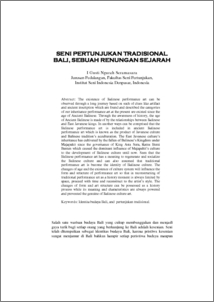I Gusti Ngurah, Seramasara
(2007)
SENI PERTUNJUKAN TRADISIONAL BALI, SEBUAH RENUNGAN SEJARAH.
Mudra (JURNAL SENI BUDAYA), 20.
p. 1.
ISSN 0854-3461
![[img]](http://repo.isi-dps.ac.id/style/images/fileicons/application_pdf.png)  Preview |
|
PDF (SENI PERTUNJUKAN TRADISIONAL BALI, SEBUAH RENUNGAN SEJARAH)
- Published Version
Download (184kB)
| Preview
|
Abstract
The existence of Balinese performance art can be observed through a long journey based on such of clues like artifact and ancient inscription which are found and described the categories of our inheritance performance art at the present are existed since the age of Ancient Balinese. Through the awareness of history, the age of Ancient Balinese is made of by the relationships between Balinese and East Javanese kings. In another ways can be comprised that the Balinese performance art is included in ancient Balinese performance art which is known as the product of Javanese culture and Balinese tradition’s acculturation. The East Javanese culture’s inheritance has cultivated by the fallen of Balinese’s Kingdom under Majapahit since the governance of King Asta Sura, Ratna Bumi Banten which caused the dominant influence of Majapahit’s culture to the development of Balinese culture until now. Seen that the Balinese performance art has a meaning to regenerate and socialize the Balinese culture and can also assumed that traditional performance art is become the identity of Balinese culture. The changes of age and the existence of culture system will influence the form and structure of performance art so that in reconstructing of traditional performance art as a history moment is always limited by space, proceed with time and reconstruct to the artist’s style. The changes of form and art structure can be possessed as a history process while its meaning and characteristics are always powered and prevented the genuine of Balinese culture art.
Actions (login required)
 |
View Item |


